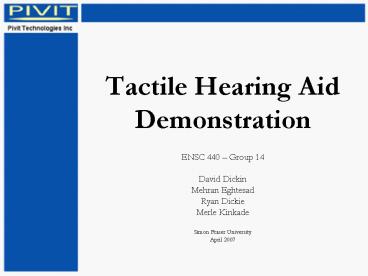Tactile Hearing Aid Demonstration - PowerPoint PPT Presentation
Title:
Tactile Hearing Aid Demonstration
Description:
PCB fabricated to drive vibrators. Connects software to VibraPad ... Why 16 Vibrators? Parallel port limitations. Space limitations. Power restrictions ... – PowerPoint PPT presentation
Number of Views:455
Avg rating:3.0/5.0
Title: Tactile Hearing Aid Demonstration
1
Tactile Hearing Aid Demonstration
- ENSC 440 Group 14
- David Dickin
- Mehran Eghtesad
- Ryan Dickie
- Merle Kinkade
- Simon Fraser University
- April 2007
2
Outline
- Introduction
- Software Subsystems
- Hardware Subsystems
- Business Case
- Experimental Results
- Conclusion
- Demonstration
3
Introduction
4
Team Members
- David Dickin CEO
- Mehran Eghtesad Senior Hardware Designer
- Ryan Dickie Senior Software Designer
- Merle Kinkade CFO
5
What is a Tactile Hearing Aid?
- A device that translates noise into touch
- Used to help the hearing impaired
- Traditional hearing aids cannot be used by all
people
6
System Overview
7
Subsystems
8
Software Subsystems
9
Technologies
- Wav Reader/Writer self-designed.
- FFT FFTW (Fastest Fourier Transform in the West)
- Audio Input/Outer Windows Multimedia Library
- Parallel Port Inpout32.dll
- Drawing GDI
- GUI Winapi
- Misc Boost C libraries
10
GUI User Interface
11
Audio IO
- Runs in separate threads
- 44100 Hz, 16-bit, mono
- Can load/save to wav files
- Can use microphone input
12
DSP
- Hamming Windows
- R2C DFT with N 4096
- Threshold Filtering
- Critical Transform ? Bins
- Buzzer Amplitude Mapping
13
Parallel Port Interface
- Runs in a separate thread
- Updates in 1ms intervals
- Buzzer amplitude achieved by pulsing buzzers
- Uses inpout32.dll driver
14
Hardware Subsystems
15
I/O Control Board
- PCB fabricated to drive vibrators
- Connects software to VibraPad
- UI is on/off switch and intensity knob
16
VibraPad
- Why 16 Vibrators?
- Parallel port limitations
- Space limitations
- Power restrictions
- Worn on stomach/torso area
- Largest even surface area without contour issues
- Large network of nerve endings
- Velcro for repositioning and ease of array
placement
17
Proposed Mappings
Uniform
Offset
Offset with Snaking
Offset with Snaking Natural Mapping
18
Transforms/Mapping
- Critical Bands based on Frequency Response of
Human Ear - Critical Band Mapping based on Bark Scale
- Below 500Hz ? Uniform bands of 100Hz intervals
- Above 500Hz ? Bands increase non-uniformly with
Frequency
19
Bark Scale Divisions
High resolution below 500Hz
Human voice 500Hz2kHz
- Optimum range 2kHz4kHz
Resolution decreases Rapidly above 4kHz
http//ccrma.stanford.edu/jos/bbt/Bark_Frequency_
Scale.html
20
Business Case
21
Budget and Funding
22
Schedule
23
Market Overview
Statistics obtained from publications of the
National Institute on Deafness and other
Communication Disorders (NIDCD) based on the
American population and published at
http//www.employmentincentives.com/state_incentiv
es/documents/statistics_about_hearing_loss.doc.
24
Experimental Results
25
Goals
- Goals
- The purpose of this project is to determine the
extent and limitations of the tactile sensory
system to receive and translate sound
information. Such measures will be quantified by
outlining specific test procedures and conducting
these tests on several individuals. Project
Proposal - Criteria for Success
- To deem a series of experiments successful, a
minimum hit rate of 80 must be achieved after a
maximum of 100 minutes of cumulative training, or
5 iterations of the above experiment. Design
Specifications
26
Experiment 1 Procedure
- 10 short sound clips
- Sirens, bells, animals, vehicles, etc.
- Subjects allowed to hear sounds
- Training time
- One by one with audio open ended
- One by one without audio open ended
- Random max 10 minutes
- Operator-assisted training max 10 minutes
- Two set of Transforms
27
Transforms
- Transform 1
- Frequency bins determined based on critical bands
- Transform 2
- Frequency bins divided equally in log scale
28
Experiment 1 Results
- Conducted on 4 people
- Transform 1
- Average Hit rate 95
- Average Training time 20 min
- PASS
- Transform 2
- Average Hit rate 100
- Average Training time 16 min
- PASS
- TOO EASY?
29
Experiment 2 Procedure
- Changes from Experiment 1
- 30 short sound clips
- Normalize length of clips (3-4 sec)
- Subject not allowed to hear sounds
30
Experiment 2 Results
- Conducted on 4 people
- Transform 1
- Average Hit rate 55
- Average Training time 43 min
- FAIL
- Transform 2
- Average Hit rate 53
- Average Training time 35 min
- FAIL
- TOO HARD?
31
Redesign Changes
- Based on user feedback and comments as well as
our personal observations - Create Transform 3 compromise of uniform and
critical band - Change VibraPad layout
- Change different intensity levels (PWM)
32
Vibrator Layout
Experiment 1/2 Layout
Experiment 3 Layout
33
Experiment 3 Procedure
- Large scale test (20 subjects)
- 10 short sound clips of the same length
- Sirens, bells, alarms, cars, etc.
- Limited training time
- Self directed 7 minutes
- Operator-assisted 7 minutes
- Provide a list of sound names to subjects
- Using transform 3
34
Experiment 3 Results
- Conducted on 23 individuals
- Average hit rate 68
- Average training time 17.5 min
35
Experiment 3 Results
- Previous exposure
- Our group 97.5
- Everyone else 61
- Age
- 16 Individuals under 35 77
- 7 individuals over 35 44
36
Conclusion
37
Summary
- Participants are able to identify sounds with
practice - High pitched sounds, like alarms, are easy to
distinguish - More testing required, but has some marketability
- Project stayed on schedule and budget
38
Acknowledgements
- Thanks to the ESSEF and the Wighton Fund for
funding for our project - Thanks to the ENSC 440/305 Professors and TAs
for their time and assistance
39
Questions?
Go Canucks!
40
Similar Devices
- Audiotact
- Tacticon
- Tactaid
41
Bark Scale Divisions
http//ccrma.stanford.edu/jos/bbt/Bark_Frequency_
Scale.html
42
Standards
- Standards Council of Canada
- CSA
- ANSI
- ISO
- FCC
- ECMA































